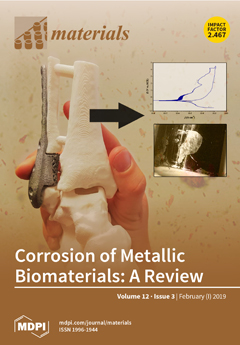Electronic, vibrational, and anharmonic studies on some binary clathrate A
xSi
136 (A = Na, K, Rb, Cs; 0 <
x ≤ 24) are theoretically presented. The Fermi energy lies in the range of 1.1 eV to 1.4 eV for Na
x
[...] Read more.
Electronic, vibrational, and anharmonic studies on some binary clathrate A
xSi
136 (A = Na, K, Rb, Cs; 0 <
x ≤ 24) are theoretically presented. The Fermi energy lies in the range of 1.1 eV to 1.4 eV for Na
xSi
136 and increases as stoichiometry (
x) is tuned from 8 to 12 to 16. The determined isotropic “Mexican-hat” shape of the guest-host potential describing Na motion in the Si
28 cage indicates the “off-center” position when the temperature is elevated beyond zero. Accordingly, the calculated Na “off-center” displacements correlate well with the X-Ray Diffraction (XRD) data (0.4 Å–0.5 Å) for a similar composition range (0 <
x < 24). The lack of first-principles analysis on quartic anharmonicity motivates us to initiate a self-consistent model to examine the temperature-dependent rattling frequency
Ω(
T) of the guest (Na, Rb). The predicted values of
Ω(
T) for Na
24Si
136 at 300 K are significantly higher (approximately six times larger) than the value at absolute zero, which contrasts with the case of Rb
8Si
136. Moreover, underestimation of the isotropic atomic displacement parameter
Uiso is caused by the temperature-dependent quartic anharmonicity of Na, and this discrepancy might be offset by the square of the “off-center” displacement.
Full article






